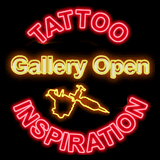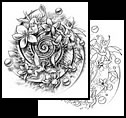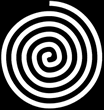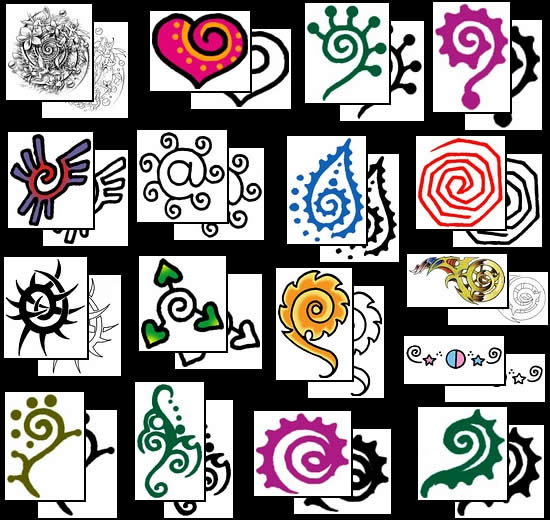|
|
|||
 |
|||
|
TATTOO DESIGNS & SYMBOLS - SPIRALS
Tattoo Symbol Index - A B C D E F G H I J K L M N O P Q R S T U V W X Y Z Tattoo designs - S >> Spirals
Carl Jung proposed that symbols appear when there is a need to express what thought cannot think or what is only divined or felt. Tattoo designs and symbols, whether spirals or not, can also help us express what we feel but can not explain verbally. That may explain why some of the oldest examples of prehistoric art include spiral shapes painted or carved into rock. In fact, the spiral has left no human culture untouched. The symbol appeared in civilizations one after the other, notably Roman, Greek and Celtic, who freely decorated the objects of their culture with many mysterious motifs. The Celts even painted spirals on their naked bodies as an intimidation tactic while in hand-to-hand combat. Of course, the tattoo world is well familiar with the ancient Celtic genius for twisting plant and animals motifs into incredibly knotted spirals - a symbol for reaching the soul, attempting to understand God, the Universe and our place in it. For the Celts, there existed a Great Cosmic Loom that expressed the notion of a never-ending spirit. Aboriginals in Australia often drew the spiral as a coiled snake. Islamic art, which prohibited the portrayal of people or animals in art, made good use of the spiral in its many glorious geometric designs. Spirals can also be found in oriental and Indian decoration. Spirals keep showing up even today in the graphic logos of many organizations, usually symbolizing eternity, but also magic, dreams, and desires. And if the spiral is spinning, it imparts a sense of calm. Many indigenous cultures use the spiral to show that there is a conscious energy force within all living things. But this mystical notion has even been expressed mathematically, the pattern a consequence of'complex sequences, equations and algorithms which nature utilizes in her designs of the Universe.' (www.ancientspiral.com) But as the writer notes,'mathematics alone cannot justify the lure of the spiral to the human mind.' Men as logical and as scientific as Archimedes, Leonardo and Sir Issac Newton, all of whom had a profound impact on our understanding of the world and universe we live in, contemplated the spiral with a sense of wonder approaching awe. They saw in the spiral God constructing the Universe. Spirals are a timeless motif in the design of our corporeal existence - from the brain to the fingertip to the entire nervous system -- so it's little wonder they exist also in our psyches. Joseph Campbell saw the center of the spiral as a symbol for our spiritual'home'. He also respected the urge to embark on the mythical pilgrimage to God as woven into our psyches, which Campbell saw as a spiral journey, traveling and moving, getting ever closer to the center. The spiral journey is a process of continual growth and becoming, and repeated death and rebirth, of which there is no end, and no straight lines.
The Double Spiral design is similar in symbolism to the familiar Yin-Yang symbol, or T'ai Chi Circle. The double spiral symbolizes the interconnection of and interdependence of opposites, hot and cold, wet and dry, male and female, birth and death, or birth and "rebirth" following an initiation or rite of passage, such as the transformation between adolescence and adulthood or religious conversion.
The Triple Spiral is found in multiple cultures around the world. Closely associated with Celtic art and designs found in the areas of Iberia and Gaul, the triple spiral spread into all the areas penetrated by the Celts as traders, in particular among the northern Scandinavian tribes. The triple spiral, or Celtic triskele was a solar symbol of great antiquity. The design was assimilated by early Christians to symbolize the Holy Trinity, God the Father, Christ the Son and the Holy Spirit. This is a pattern repeated among early Christians with plants like the shamrock and the strawberry, which have three leaves. Today, the triple spiral has been adopted by some neo-pagans as a design that symbolizes the Triple Goddess.
Equiangular spirals describe a family of spirals. It is defined as a curve that cuts all radii vectors at a constant angle.
Explanation of equiangular spirals:
See also: Crosses, Maori Tattoo Designs For those who love the purity of mathematics visit this site. Tattoo Johnny Tattoo Designs - Different spiral tattoo design ideas by some of the world's top tattoo artists and illustrators. Tattoo designs - S >> Spirals Tattoo Symbol Index - A B C D E F G H I J K L M N O P Q R S T U V W X Y Z |
||
Tattoo Designs provided by TattooJohnny.com |
|||
| Celeb Tattoos | Facts & Stats | Designs & Symbols | History | Culture | Links | Tattoo Galleries | Contact | |||
|
|
|||





 Spiral
Types
Spiral
Types





